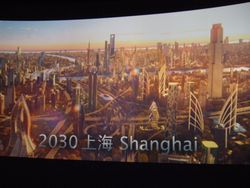The Lost Glamour of World's Fairs
 Americans long ago consigned world's fairs to the toy box of history. Once celebrated as showcases of world cultures and windows into the future, these grand expositions lost their glamour sometime during the Johnson administration. Like Space Food Sticks and Jonny Quest, they are fondly remembered — at least by those over 50 — but a bit ridiculous: all that ethnocentricism, naive internationalism, and technological good cheer. The last one to warrant much attention was Montreal's Expo '67, from which the now-defunct baseball team took its name. (Sorry, Seville '92.) Our cynical culture is done with world's fairs.
Americans long ago consigned world's fairs to the toy box of history. Once celebrated as showcases of world cultures and windows into the future, these grand expositions lost their glamour sometime during the Johnson administration. Like Space Food Sticks and Jonny Quest, they are fondly remembered — at least by those over 50 — but a bit ridiculous: all that ethnocentricism, naive internationalism, and technological good cheer. The last one to warrant much attention was Montreal's Expo '67, from which the now-defunct baseball team took its name. (Sorry, Seville '92.) Our cynical culture is done with world's fairs.
Not so for Shanghai, where Expo 2010 opened on May 1 and runs through October. In its first two months, the Shanghai Expo attracted more than 20 million visitors, mostly from China itself. Spanning more than 1,300 acres on both sides of the Huangpu River, the fair is an ubiquitous presence throughout the city. Public gardens reproduce the logo in white flowers, subway-car TVs broadcast upbeat interviews with exhibitors and tourists, huge LED screens on downtown buildings play promotional videos, and street vendors hawk knockoffs of its squat, blue, Gumby-like mascot. Visiting Shanghai in May, I quickly discovered that the Chinese authorities haven't lost their zeal for propaganda. They've just changed their colors from revolutionary red to Expo green.
Taking place in a society that is both authoritarian and rapidly developing, the Shanghai Expo highlights the double-edged allure of world's fairs, which are both deceptive and inspiring. The Expo's cheery boosterism and sanitized reality match Lawrence R. Samuel's description of the 1964 New York World's Fair in The End of the Innocence: a "protective cocoon" where "foreign nations sang in harmony, corporations existed to produce things that made life better, and, most important, the future looked brighter than ever." Like all glamorous objects, the '64 fair was an illusion. Yet its optimistic spirit, and those of other fondly remembered world's fairs, fostered attitudes that often did produce real progress. "For the tens of millions of kids who went," writes Samuel, who was one of them, the fair "planted a seed of the possibility to achieve great things."
Read the rest on BigQuestionsOnline.com, a new website for which I'll be writing a monthly column.
[Shanghai 2030 is a still taken at the GM pavilion's video which, like GM exhibits at the 1939 and 1964 New York World's Fairs, foresees a future of self-navigating cars.]